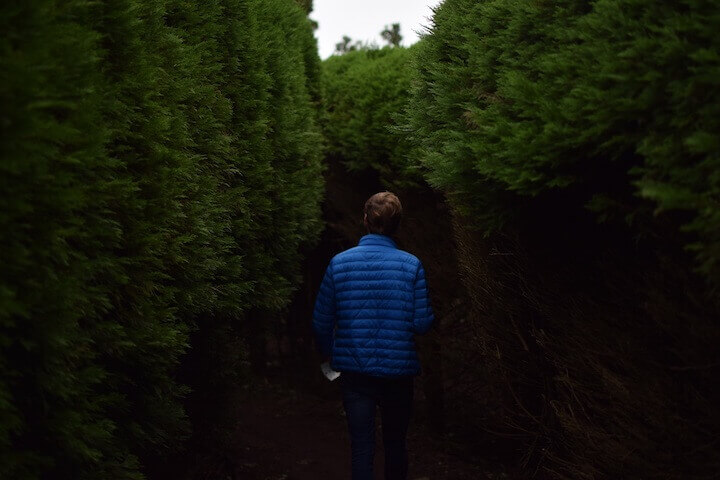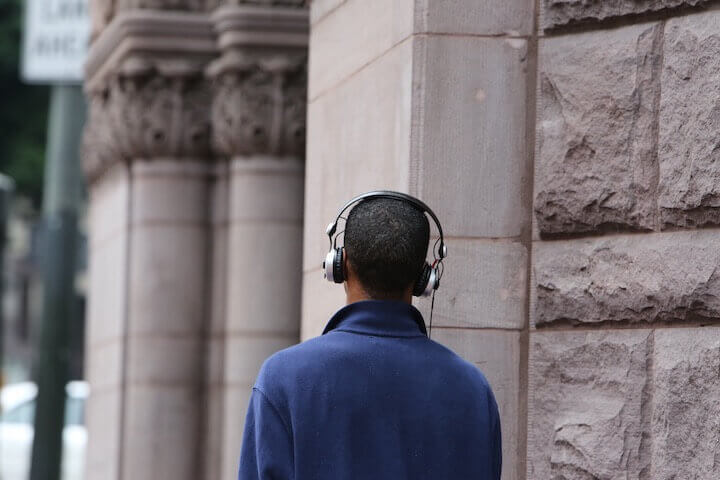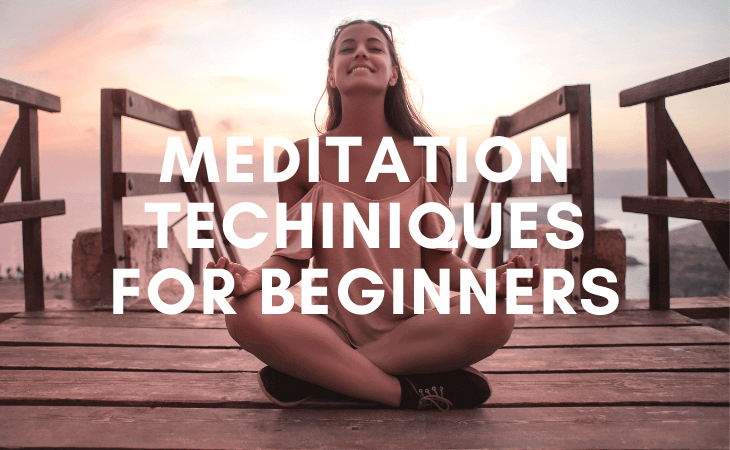Looking for the best meditation techniques for beginners?
If you’ve been trying to get your meditation practice going for any time at all, then chances are you’ve come across countless meditation techniques. Even though meditation at its core is quite simple, the technique you’re using might not be the best fit for you.
Lucky for you there are dozens of meditation techniques for you to choose from. If you’re just getting started it’s recommended to try a few out until you find the one that suits your needs and lifestyle the best.
Below we offer a breakdown of 25 of the most common beginner meditation techniques and types of meditation, and give you some guidance for choosing the best beginner meditation technique for you.
Whether you’re looking for a spiritual meditation, something to help you unwind at the end of the day, or a practice that you can explore for life, the list below will have something for you.
How to Choose the Right Beginner Meditation Techniques
It’s important to not get overwhelmed during the selection process. You can change your mind. Be open to experimentation. Just make sure you’re not jumping from practice to practice, because you aren’t feeling the “effects” or “seeing results”. Meditation can be incredibly valuable, but only if done for the long-term.
When choosing amongst the many different meditation techniques, it’s important to choose one that you’re immediately interested in.
This interest and curiosity can help to carry you through any initial roadblocks you might experience.
Below we explain a few meditation techniques you have available to choose from, the benefits of various techniques, and a few steps to help you get started. We even dive into some more advanced meditation techniques and meditation exercises.
1. Chakra Meditation
Chakra meditation widely used in yoga practices, and was first mentioned in the Vedas, but is used in a wide variety of meditation techniques today. There are a number of chakra meditation techniques available, but most follow the same premise of focusing your attention on the seven energy centers of the body, and doing either visualization, mantra, or breathing on those points.
The seven energy centers of the body (or chakras), are as follows:
- Root: the root chakra is located at the base of the spine and is connected to our feelings of being grounded and present in this world.
- Sacral: the sacral chakra is located a couple inches above the belly button, and is connected to feeling of pleasure, creation, and sexuality.
- Solar Plexus: the solar plexus chakra is located in the upper abdomen area and is linked to our levels of confidence and control in our lives.
- Heart: the heart chakra is located a few inches above our heart and is linked to our ability to give and receive love.
- Throat: the throat chakra is located in your throat and is connected to our ability to communicate.
- Third-Eye: the third-eye chakra is located between your eyebrows and is connected to intuition, imagination, and our ability to see our connection to the bigger picture.
- Crown: the crown chakra is located at the very top of your head and is linked to our overall spiritual connection.
Meditating on each point is said to clear any blockages that might have arisen. Energy blockages at any of the energy centers can lead to the physical manifestation of a host of symptoms.
The most common chakra meditation for beginners involves focusing on the sacral, heart, and third-eye chakra, breathing in and out at each point and focusing your attention there for a few minutes.
2. Taoist Meditation
Taoist (or Daoist) meditation refers to the meditative practices that are associated with the philosophy and religion of Taoism. With the main focus being uniting oneself with nature and living in harmony.
There are a variety of taoist meditation techniques available for you to explore. The most common being visualization, contemplation, mindfulness and contemplation. Taoist meditation practices are highly intertwined with Buddhist meditation practices, such as, insight meditation. Most modern forms of Taoist meditation are focused upon improving health and longevity.
Below we outline a few different Taoist meditation practices:
1. Alchemical Meditation
This meditation is very simple, but very difficult in its simplicity. There is no technique, instead your existence becomes the meditation. Every sensation, every thought, every emotion is the perfect manifestation of one’s true nature. It’s wholly perfect, and every moment is utterly sweet. It’s the pathless path to meditation.
2. Inner Smile and Microcosmic Orbit
One of the most widely read and popular western teachers of Taoist meditation is Mantak Chia, the main focus of his meditation methods involve inner alchemy through inner smile meditation and the circulation of Qi energy.
This style of meditation focuses on opening up the energy channels of the body and enhancing the flow of energy throughout the body, down the front into the sacral point and up the spine. This meditation is used to increase energy and inner healing, and bring harmony to the body, mind, and spirit.
3. Osho Meditation
Osho is no doubt a controversial figure and his work seemed to embody the paradoxes he often spoke about. His philosophies draw on many different styles of spiritual and philosophical thought, ranging from Nietzsche, to Zen, to various spiritual traditions, to the ancient beliefs of Heracutis, and occultist Gurdijeff.
Osho developed hundreds of different meditations throughout his life, the most popular meditation being Dynamic Meditation. He believed that modern man was not quite ready for classical meditation techniques, and his active meditations would give the practitioner a deep cathartic release, along with an experience of deep meditation. After which they would be able to more easily emerge themselves in classical forms of meditation.
We outline the practice of Osho’s Dynamic Meditation below:
Step 1: Breathe in a chaotic fashion in and out of the nose. Your posture doesn’t matter as much as you keep on breathing until you are consumed by breath. Keep this up for 10 minutes.
Step 2: Let your entire body explode, get out everything you have to. Yell, scream, shake, do whatever you have to do as you follow your body through this release. Do this for 10 minutes.
Step 3: Next you’ll jump up and down with your hands in the air for 10 minutes repeating the mantra ‘Hoo! Hoo!’. As the soles of your feet land on the ground feel the energy settling in your root and sacral chakras.
Step 4: Stop your body entirely in whatever position your body is in. Don’t move, just witness the sensations that are present in your body. Hold this position for 15 minutes.
Step 5: In the final step of the meditation you’ll celebrate life and dance and move however your body wants to express itself. Do this for 15 minutes. It can be helpful to play music.
4. Deep Meditation
Deep meditation doesn’t refer to any specific meditation practice or technique, but simply a way to experience deeper meditation sessions. The tips mentioned below can be utilized in addition to most other meditation techniques.
Think of it as a way to set the scene for a deeper and more impactful meditation to follow. Simply sitting down and starting to meditate is what most people do when they first begin meditating, however, it can be much more powerful to actively prime the pump to have a deeper meditation session.
In fact, if you feel like your meditations have only been skimming the surface and you’re not particularly inspired by your practice at the moment, it can be very beneficial to “go deep” into uncharted and relaxing waters.
- Journal Away Your Thoughts
In the Western world most (all) of us are obsessed with doing. If we’re not moving forward, then we’re falling behind. Naturally, this isn’t the best state of mind to dive into meditation with. So, one of the more effective ways to slow your flow of thoughts before you meditate is to journal them away.
Some refer to this as a brain dump. And that’s exactly what you’re going to be doing. Open up a blank page in your journal (this works best when you write it out as opposed to typing) and set a timer for 5-10 minutes. Then, write until the timer goes off. Don’t worry about spelling, or the topic, or anything, the goal is to literally dump all of the thoughts spinning in your head out onto the page.
- Take Time to Calm Yourself
Instead of setting your meditation timer right away we’re going to spend some time relaxing first. Spending a few extra minutes up front can make for a much more enjoyable meditation.
Sit in your normal preferred meditation pose and take five deep breathes. Breathe deep into your belly, and as you exhale imagine all of the stress leaving your body. Let the tension in your shoulders and face melt away. Use this time to notice any tight spots in your body and breathe into them.
After doing this for a few minutes you’re going to feel much more relaxed.
- Sink Into Joy
Finally, you’re going to spend some time in gratitude. It’s much easier to sit in meditation when you’re in a grateful state of mind. Think of something you’re grateful or happy about in your life. Or, someone that you truly care about.
Let the good feelings start to flow and really start to feel all of the associated positive emotions. The more you get into it, the better you’re going to feel.
Once you’ve completed the above you’re going to feel incredibly relaxed and ready for a truly profound meditation.
5. Morning Meditation Techniques

What could possibly be a better way to start the day than a nice refreshing meditation.
Meditating first thing in the morning truly creates the space and perspective for a beautiful day to follow. Morning routines are truly a powerful way to start the day. Instead of immediately being in reactive state of mind the moment you wake up, you’re going to take your power back.
Honestly, you could do any of the meditation techniques mentioned in this post first thing in the morning, but we’re going to outline one of our favorite morning meditations below.
- Assume the position: Sit in your preferred meditation position and take a few deep breaths.
- Relax and imagine: As you settle into your meditation feel every part of your body relaxing. Imagine yourself in the day ahead. How do you want to navigate through the day? What will happen? What will you do? Walk through your day in the most blissful manner possible.
- Set your intention: Now, settle onto an intention for the day. Something like, ‘today is unfolding better than expected’, or ‘I handle the day with grace and ease’. Something that feels good and true to you.
- Breathe it out: As you focus on that intention and repeat it over and over hook the intention onto your breath. As you exhale imagine those words surrounding you. Inhale and exhale your intention until you feel ready for the day ahead.
The meditation highlighted above can be a great daily meditation to add to your routine.
6. Deepak Chopra Meditation
Deepak Chopra is a well-known figure in the spirituality, new age, and alternative healing spaces. As a result, you’ve probably come across some of his meditations.
The goal of his meditation techniques are to bring you back to a point of peace and love. Deepak has teamed up with Oprah to offer a 21-day meditation experience, that a lot of people have called truly transformative. Their meditations utilize a variety of breathing, relaxation, and visualization techniques.
If you’re interested in following along with Deepak and Oprah, then you can join their program here. Or, if you’re looking to test the waters first, they offer a variety of guided meditations that can be used for different occasions.
7. Walking Meditation

Walking meditation can be a great way to introduce your meditation practice into your “real” life. Plus, if you’re having trouble sitting still during meditation, then this can be a great bridge into seated meditation. Often, it’s much easier to fit walking meditation into our lives; a simple walk to the grocery store can act as your daily meditation.
A lot of different schools of meditation incorporate the use of walking meditation into their techniques. Including Zen, Theravada, Taoism, and Yoga. Walking meditation is much more than just talking a walk, usually it’s much slower and involves a focus on the breath or the sensation of walking.
Below we outline a simple walking meditation that can align with your mindfulness meditation practice:
The goal of this practice is increased awareness, instead of paying attention to a single element of your walk you’re going to be observing and witnessing the entire experience of walking.
- Pick a spot where it’s unlikely that you’ll be disturbed. When you’re just getting started it can be helpful to practice in your backyard.
- As you walk you’re going to use every sensation you experience to bring you into the present.
- Feel your feet touching the ground. Feel how your legs balance, and your muscles flex and relax with each step you take.
- Be aware of your breath and how to flows in and out of your lungs.
- Feel how the air feels against your skin. How the fabric of your clothes brushes against your body.
- Notice the sensations of the world around you. The noises, the smells.
- Be aware of your entire body. Do a body scan from the top of your head down to the bottom of your feet.
8. Kundalini Meditation
Kundalini meditation is a very complex practice. It’s highly recommended that you only practice Kundalini meditation in the presence of an experienced teacher.
The goal of Kundalini meditation is to awaken the dormant kundalini meditation that lies dormant at the base of the spine. There are a lot of dangers associated with this practice, and the technique shouldn’t be attempted without the guidance of an experienced yogi.
Kundalini meditation involves intense breathwork and the opening of the root chakra. The goals of this style of meditation involve cleansing the mind, balancing the chakras, and ultimately achieving enlightenment.
To learn more about Kundalini meditation, check out this great resource from Gabby Bernstein.
9. Mantra Meditation
Mantra meditation stems from Hindu and Yogic traditions. It’s been popularized in the West with the growth of Transcendental Meditation (TM), which we profile below. A mantra is usually a sound or a word without a particular meaning, that you repeat time and time again.
This repetition helps to put your mind at ease and gives you something to focus on. If focusing on your breathe alone is too difficult, then mantra meditation is a great place to start.
There are a variety of mantras for meditation, and some teachers specify that the meditation mantras you use are very important, due to the vibrational quality of the mantra. The most common mantra that you’ve surely heard before is ‘Om’.
Mantra meditation is traditionally practiced using a seated meditation posture. The mantra in then repeated silently for a set period of time. Repeating a mantra gives your mind something to do and helps you to disconnect from your thoughts, so you can slip into the gaps between your thinking.
Mantra meditation is a great practice for beginner meditators.
10. Healing Meditation
Meditation is a very healing practice. Most of our minds drive us crazy and as a result we end up living with severe amounts of anxiety, stress, and worry that can manifest as a host of other symptoms. Practicing meditation on a regular basis can help to heal our minds and this translates to increased health in other aspects of our lives.
Every meditation practice featured on this list will help to bring some aspect of healing into your life. But, some style of meditation focus on healing more than others. We dive into a few of those below.
1. Prana (Life Force) Cultivation
Prana meditation has to do with cultivating more life force within you. Breath is the key tool that brings prana into our bodies.
For this meditation we’re going to focus a bit more on the breath.
Sit or stand in a comfortable posture. As you breathe imagine a luminous light surrounding you. As you inhale you’ll inhale in this light, and exhale the same way.
Some forms of this meditation even focus on the three main chakra points: your sacral (at the base of your spine), your heart, and your third-eye.
2. Deep Breathing Meditation
According to ancient traditions breathing can be very healing. However, in our modern culture most of us have forgotten how to breathe properly.
Instead of the deep healing full belly breaths that utilize all of our lung’s potential, we take shallow chest breaths that lead to a host of negative symptoms.
With this meditation exercise we’re going to take our power back and lay down the pathways of proper breathing. This is very simple in all that we’ll be doing is taking deep breaths.
Sit, lie down, or stand. Take a deep breath through your nose and inhale into the bottom of your belly. Then, fill up the top of the lungs by expanding your chest.
Inhale until you can’t anymore. Hold for a five count. Then exhale slowly.
Repeat for a cycle of 8 breaths. You can do this as long as you’d like.
3. Loving-Kindness Meditation
Loving-Kindness meditation is also known as metta meditation. The basis of this meditation deals with directing feelings of kindness towards ourselves and others.
This meditation is great in that it leaves you feeling full of love throughout and after the meditation. Who doesn’t want that?
We offer a longer profile of this meditation below, check out #12.
11. Zazen Meditation
In Zen buddhism the style of meditation most commonly practiced is called Zazen meditation. This style of meditation has been practiced relatively the same for over 2,500 years. The teachings and meanings behind Zazen vary depending on the school. But, the core truth behind the practice is allowing you to see into the nature of existence.
Pretty deep stuff.
How to Practice Zazen Meditation
One of the main elements of Zazen meditation is the focus on posture as a concentration tool. The most important elements of this meditation are your posture and your gaze.
- Zazen meditation posture is typically done in the classic lotus pose, or sitting in a chair with your back upright.
- Once you’ve settled into your posture you’ll fix your relaxed gaze a few feet in front of you, pointing towards the ground. Reminder, your eyes are open for this one. But, don’t strain your vision, your eyes should still be relaxed and almost closed.
- With your posture and gaze steady most beginners can utilize a count to keep their attention. With each inhale you count 1, all the way up to 10. Then, once you’ve reached 10, you count backwards to 1. Then, you repeat the process until the timer goes off.
This is a very basic version of Zazen meditation. For those interested in this practice we recommend checking out a local Zen center, or checking out the book The Three Pillars of Zen.
12. Metta Meditation

Metta can be translated to mean kindness and compassion. Metta meditation is also referred to as loving-kindness meditation. The purpose of this meditation is to develop kindness and compassion within yourself, and extend this outward towards others. This meditation is great in that it makes you feel incredibly good by the time you’re finished with the practice.
Over time, this meditation will help to build the amount of unconditional love you have within yourself, and it will become natural for you to extend this kind of love outwards towards others. Metta meditation also has a lot of scientific backing, in regards to its benefits.
How to Practice Metta (Loving-Kindness) Meditation
This meditation typically deal with the repetition of the phrases, “may you be happy” and “may you be free from suffering”. As you sit into meditation feel good-will and love in your own heart, then extend that love outwards into the four areas highlighted below.
It can be helpful to visualize these people and generate as much feeling-energy as possible.
Direct your love and good-will towards:
- Yourself
- A friend
- Someone you feel no feelings towards
- Someone you actively dislike
The more frequently you practice this meditation the more joy and happiness you’ll feel on a regular basis.
13. Guided Meditations
When you’re searching around for various beginner meditation techniques you’ve probably come across various guided meditations and online meditations. These meditations can actually be a great jumping off point for your own practice.
Since we live in such a chaotic and distracting world guided meditations can help you actually stick with your practice and give you a reason to meditate.
If you don’t have a meditation teacher to guide you through your meditation, then using guided meditations can be of great assistance. Of course, they can’t replace the value that an experienced meditation teacher can bring. That’s near impossible to do.
Guided meditations can help you drop into the meditative state more quickly, and are usually geared towards specific purposes.
If you’re interested in exploring guided meditations, then check out this wonderful list from Purpose Fairy. We hope to put together our own list soon, but this is a great jumping off point.
14. Third Eye Meditation
Third eye meditation is said to open the “third eye”, the area just above and between your eyebrows. Opening this point is said to bring about increased intuition and perception beyond ordinary sight. We like to think it’s something like William James described with this quote: is said to open the “third eye”, the area just above and between your eyebrows. Opening this point is said to bring about increased intuition and perception beyond ordinary sight. We like to think it’s something like William James described with this quote:
If the doors of perception were cleansed every thing would appear to man as it is, Infinite.
Awakening your third eye is said to bring about a sort of spiritual vision. You’re able to see things how they actually are with piercing insight and wisdom.
The third eye is mentioned across various traditions, including, Hatha Yoga, Chakra meditation, some schools of Zen, and much more.
Meditating on your third eye can be done in a variety of ways. We offer the simplest method below, that draws from the Chakra meditation technique highlighted above.
How to Open Your Third Eye
Below we offer a simple third eye meditation to get you started cultivating your intuition and insight.
- Get comfortable and assume a meditation posture that allows you to go deep and relax.
- As you sit take a few deep breaths and as you exhale imagine all of the tensions and stresses of the day slipping away.
- Bring your awareness to your third eye point (in between your eyebrows and slightly above).
- As you breathe inhale and exhale through the third eye point. Imagine energy flowing through the point. It can help to visualize the energy being a cool blue color.
- Breathe until your timer goes off.
When dealing with the upper chakras it can be tempting to drift higher and higher into upper states of consciousness. However, it’s also important to ground yourself in your body. When doing this style of meditation on a regular basis it’s also a good idea to move your body and workout, so you can integrate and ground this new energy.
15. Transcendental Meditation
Transcendental Meditation or TM was introduced to the world in the early 60’s by Maharishi Mahesh Yogi. It’s practiced quite widely, and has been supported by a number of famous celebrities and public figures.
The practice itself is not free. You must learn the practice from a certified teacher. However, it is known that they use a type of mantra meditation, and you are instructed to meditate in two 20 minute sessions a day.
It can be an easy enough practice for beginners, but the initial cost of the program can deter a lot of people. If you’re interested in learning more about this technique we recommend checking out their website here.
16. Tibetan Meditation

Tibetan Buddhism has many different schools and lineages. However, the chief attainment of most Tibetan Buddhist practices is to reach buddhahood for the benefit of all sentient beings. The main factor in this “achievement” is meditation.
There’s an extensive list of Tibetan Buddhist teachers across the East and West who have brought these teachings to life.
Below we offer a few common Tibetan Buddhist meditation that utilizes an image of the Buddha as the focal point for the meditation.
1. Following the Breath
- Sit cross-legged on the floor, with your spine upright.
- Place your hands on your lap with your palms facing upwards and the tips of your thumbs touching.
- Tuck your chin inwards slightly, and close your eyes, or keep them open with a slight gaze.
- Close your mouth and press the tip of your tongue onto the roof of your mouth.
- Bring your focus to the liberation of all being from suffering and hold this wish in your heart.
- Now, bring your attention to your breath, and focus on your nostrils and feel the breath exiting and entering your nostrils.
- Keep your attention on your breath until your timer goes off.
For a great introduction to Tibetan meditation, check out this post. Or, if you’re interested in going deeper into Tibetan Buddhism, then this is a great primer.
2. Image of the Buddha Meditation
This meditation is more advanced in practice in that it demands the ability for you to concentrate on a given object for a period of time. Although it might seem easy, you might experience agitation when attempting this meditation to early along your journey.
The meditation involves focusing on an image of sculpture of the Buddha, so you can see it in your mind’s eye. Then, with eyes closed you continue to focus on that image and bring feelings of devotion into your heart.
17. Qigong Meditation
Qigong is a holistic system of movement and breath that can be used to improve health and bodily function, and can be used as a meditation and spiritual practice. A typical Qigong practice involves deep and rhythmic breathing, visualization, and slow repetitive movement.
There are so many different variations of Qigong, it’s near impossible to cover all of them here. Especially, while trying not to overwhelm you. Most serve different purposes and some are linked to ancient martial arts practices. However, they all have one thing in common. They are used to cultivate energy within the body.
Some Taoist meditation techniques even incorporate some Qigong style techniques.
Qigong can be a great fit for you if you’re having trouble keeping your body calm and quiet during meditation. Often practice involves and engages your body and a lot of people find it to be a very effective in silencing the mind.
Below we offer a simple seated Qigong practice for those interested in getting started with the technique.
- Sit in a regular cross-legged seating pose.
- Close your eyes and take a few deep breaths.
- As you relax bring your attention to your dantien point (the point a few inches below your navel).
- Focus your attention on this point and this will cultivate Qi energy in your body.
- As you feel this energy develop let the Qi energy circulate throughout the rest of your body.
However, the literature surrounding Qigong is very extensive and there are numerous directions you can go with your practice. For further information check out the Qigong Institute and this post from Mindvalley.
18. Relaxation Meditation

Meditation can be an incredible relaxation tool. However, when we’re first beginning our minds can be rather overwhelming and the practice will seem to be anything but relaxing. If you’ve been meditating for a while, then you may have noticed the relaxation response that meditation induces when we can truly create distance between us and our stressful thoughts.
If you’re truly looking for a way to relax and unwind, then try the meditation practice below:
- Sit in a regular meditation posture, or lie down comfortably.
- Close your eyes and take a few deep breaths to settle yourself.
- Bring your attention to your body and consciously relax every part of you. Chances are you’re holding a lot of stress inside your body.
- Make your way from the top of your head down to your toes. Breath into every part of you and consciously let go of anything you’re holding onto.
Do the above practice for as long as required. It can be helpful to do multiple body scans to truly relax the body, and through that, the mind. The above meditation can be a great meditation for sleep as well.
19. Christian Meditation
The word meditation has a wide array of meanings, and can take on different contexts depending on this religious environment it’s being utilized in. The main forms of meditation used within the Christian religion are contemplative meditation and meditation that mirrors other secular methods, such as mindfulness.
In an effort to understand and experience your relationship with God, you might find yourself lost in certain passages, or sitting silently while your mind ponders the words. These states of detachment mirror being in meditation.
One of the main methods of Christian meditation employs focusing on the love of God or God’s word. To do this, follow the steps below:
- Begin by praying for a few minutes, or contemplating a certain passage to bring you into a more relaxed state of mind.
- Focus on the greatness of God, the love of God, and feel into this with all of your heart. Surrender to God, and let everything else fall to the side.
- Sit inside this openness and stillness that has developed. There should be a feeling of surrender present.
Christian meditations can be greatly aided by practicing other non-secular forms of meditation. By being able to still your mind you’ll be able to sustain deeper levels of focus and surrender on the love of God.
20. Meditation for Anxiety
Anxiety is something that affects 1 in 14 people worldwide. So, if you suffer from anxiety, you’re not alone. Although the research that supports meditation in relieving anxiety is quite new, all of the studies are quite promising.
When you practice meditation on a regular basis the areas of your brain responsible for your self-directed thoughts actually start to change. Meditation also helps to calm the racing mind. So, instead of identifying so heavily with your thoughts, you’ll be able to identify with the silence behind and between those thoughts.
The most effective meditation for reducing anxiety is mindfulness meditation. In fact, researchers at Stanford University found that people who practiced mindfulness meditation for 8 weeks were able to minimize activity in the part of the brain that creates the fear response.
To learn more, check out our ultimate guide on mindfulness meditation for beginners.
21. Mindfulness Meditation
Mindfulness Meditation is one of the most popular forms of meditation in the West. Probably due to its ease and accessibility. In simple terms, all you’re doing is sitting and witnessing. You aren’ trying to get anywhere. You’re not trying to do anything.
You’re simply being.
Now, this seems easy on the surface. But, if you’ve never actually spent any time, just being quiet with yourself, then it can be a little difficult.
Luckily for you, we’ve written an entire primer on mindfulness meditation. This post will teach you everything you need to know about the practice and show you a few very easy ways to get started. If you’re just getting started, then this can be one of the best meditation techniques for beginners.
22. Vipassana Meditation
Vipassana meditation is almost immediately associated with the work of SN Goenka. Vipassana can be roughly translated into insight. The absolute goal of this style of mediation is to pierce through the veil of reality. Pretty deep stuff.
It originated in India and is said to be the same technique that The Buddha practiced to reach enlightenment.
This meditation technique teaches acceptance and sustained focus on your overall awareness. If you’re interested in this style of meditation one of the best ways is to immerse yourself in the practice. There are a number of free silent 10-day meditation retreats that’ll teach you the basics of this technique in a very immersive setting. To see if there’s one in your area, check out this page.
The technique of Vipassana meditation is outlined below:
- Posture: The most common posture for Vipassana meditation is sitting with your legs crossed, spine upright but not tense, and your hands resting on your knees. If this posture is too uncomfortable you can always sit in a chair. As you sit you should close your eyes and prepare to dive into the meditation.
- Breath: As you sit and breathe notice how your abdomen rises and falls. Notice how the cycle of breath continues without your active involvement. You can also notice the sensation of breathe in and out of your nostrils.
- Attention: As you sit and breathe your attention will either be upon your abdomen, or the flow of breathe in and out of your nostrils. As thoughts arise simply let them go. Let them pass through your mind. If you get wrapped up in a line of thinking, just bring yourself back to the object of your focus.
Just as we train our bodies through physical workouts, Vipassana meditation is said to train the mind.
23. Pranayama Meditation
Pranayama meditation is more of a breathing practice than an actual meditation. But, it can help to promote feelings of relaxation, reduced stress, and healing. We like to think of it as a great breathing meditation.
It has its roots in yogic traditions, and has been mentioned in ancient Yogic texts as early as 1500 B.C.E. The practice is designed to control the prana in the human body, through various controlled breathing practices.
Our Favorite Pranayama Breathing Exercises
Below we offer two easy-to-implement pranayama breathing exercises.
1. Alternate Nostril Breathing
Sit in a comfortable cross-legged posture. Cover your left nostril and inhale through the right. Then, cover the right and exhale through the left. Inhale again through the left and exhale through the right again. Then repeat this cycle.
Repeat for a minimum of seven cycles. You’ll notice that after completing a few cycles of this breathing you’ll feel much more relaxed.
2. Belly and Chest Breathing
This style of pranayama breathing uses a dual inhale technique.
Lay on your back and relax your body. You can have your hands covering your heart, or by your sides. Focus your attention on your breath. Take a deep inhale into the bottom of your belly, then take a deep inhale into the top of your chest. Followed by a long exhale.
You can breathe out of your mouth for the duration.
For a great set of guided pranayama meditations using this technique, check out the work of David Elliott.
24. Self-Inquiry Meditation
The Self-Inquiry meditation was made popular by Ramana Maharshi. Maharshi taught that by paying attention to the “I-thought”, the “I-thought” would disappear and only self-awareness would remain.
At the core of the practice self-enquiry is simply asking yourself “who am I?”, again and again. Repeatedly diving further into the answers. The great thing about this question is that it ends up driving through the intellect and bypassing the rational mind.
What is the Practice?
This practice is really cool in that it uses the mind to stop the mind. Kind of like a mental meditation hack.
The practice is simple:
- Assume a comfortable meditation posture.
- Close your eyes and ask yourself the question ‘who am I?’
- Sit with what comes up. If you get taken away with your thoughts, then bring yourself back to the question.
- Sit in the awareness that develops from this inquiry.
When you begin the process. If you’re truly honest with answering the question you’ll realize that your thoughts are not who you are, your clothes are not who you are, your job is not who you are, your body is not who are you, and on and on.
Slowly, every part of you will slip away until you’re left with the one thing you actually are. True Consciousness. There’s a lot of different words for that, so don’t let it throw you off.
25. Binaural Beats Meditation

Binaural beats meditation is a relatively new development. The jury is still out in terms of scientific validation of this style of audio, but research is being done. Still, it has been known to help people drop into deeper states of meditation.
If you’re just beginning your meditation journey it can be effective to utilize the help of audio to drop into the meditative state of mind. Just like mantra meditation, meditation with binaural beats gives your mind something to immediately hook onto.
What Are Binaural Beats?
Binaural beats are a very specific style of audio that play different frequencies of audio into each ear. Your brain then tries to align the differing audio frequencies, and this difference is supposed to increase the communication between both hemispheres of your brain.
When you meditate your brain is at a certain frequency. Binaural beats audios cause your brain to sync itself up with the frequency of the track being played. Since these tracks mirror the brain level frequency that you’ll achieve in deep meditation it’s almost like a shortcut to achieving states of deep meditation.
These audios can be a great tool for any beginner who finds it near impossible to meditate, and can be utilized during most of the meditation practices highlighted above.
In Closing
There you have it. Twenty-five different meditation techniques for you to dive into. It’s important not to get overwhelmed with the sheer amount of meditation techniques that exist.
Pick one that you resonate with and try it out.
After all, you get the most from your meditation practice when you develop a habit of doing it consistently.
—
Images via Alex Holyoake, Xochi Romero, Tycho Atsma, Ben Smith, Thomas Tucker, Sajjad Ghanavati, Leeroy
